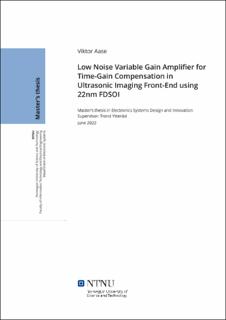Low Noise Variable Gain Amplifier for Time-Gain Compensation in Ultrasonic Imaging Front-End using 22nm FDSOI
Master thesis
Permanent lenke
https://hdl.handle.net/11250/3024151Utgivelsesdato
2022Metadata
Vis full innførselSamlinger
Sammendrag
Når en ultralyd puls propagerer gjennom kroppen blir den attenuertproporsjonalt til hvor langt bølgen propagerer for refleksjonen kan målestilbake i proben. Ettersom en ADC har konstant dynamisk område, vilsignaler som er reflektert lengre unna proben resultere i lavere oppløsningom transduseren er koblet direkte på ADCen. Tid-gain kompensering, i formav en variabel gain forsterker (VGA), er derfor lagt til mellom transduserenog ADCen. Forsterkningen økes med tiden etter en puls er sendt slik atamplituden på utgangssignalet skal vare konstant og dermed oker denmulige oppløsningen i ADCen. Denne avhandlingen foreslår en strøm-basertVGA basert på en flipped voltage follower (FVF) strømsensor (CS). VGAenhar kontinuerlig justerbar forsterkning fra 0dB til 20dB med en båndbreddepå 20MHz. Den variable forsterkningen oppnås ved dynamisk back-biasing,en egenskap ved 22nm FDSOI teknologien, for å endre den relativetranskonduktansen mellom referanse og utgangstrinnet til strømsensoren.Linearitet er karakterisert av forvrengningen av den andre-harmoniskekomponenten på utgangssignalet (HD2) og er simulert til en maksverdi påHD2 = −28.95dB uten å bruke ekstra lineariseringsteknikker. Forsterkerenlegger til lite støy på signalet og oppnår en støyfigur på 2.967dB.Inngangstrinnet på forsterkeren er single-ended, mens utgangstrinnet erpseudo-differensielt for å drive en fult-differensiell ADC. Effektforbruket tilVGAen er på 26μW. As an ultrasound wave travels through the body, it is attenuatedproportionally to the distance the wave needs to travel to return to theprobe. With the fixed dynamic range of the ADC, the resolution of featuresfurther from the probe will be worse, as the reflected signal amplitude ismore attenuated. A time-gain compensation circuit, like a variable gainamplifier (VGA), is therefore added between the transducer element and theADC. The gain is increased with time so that the dynamic range of thesignal reaching the ADC is reduced, thereby allowing greater resolution.This thesis proposes a current-based VGA based on a flipped voltagefollower (FVF) current sensor (CS). The proposed VGA has a continuousgain range from 0dB to 20dB and a bandwidth of 20MHz. Variable gain isachieved through dynamic back-gate biasing, a feature of the 22nm FDSOItechnology, to change the relative transconductance of the reference andoutput transistors of the CS. Linearity is characterized by second harmonicdistortion (HD2) and reaches a maximum value of HD2 = −28.95dBwithout any additional linearization techniques. The amplifier contributeslow noise to the signal, with a noise figure of 2.967dB. A single-ended inputstage and pseudo-differential output stage is utilized for driving a fullydifferential ADC. The power consumption of the VGA is 26μW.
